Brown Bears, birds & butterflies in the Picos de Europa & Somiedo N.P. : Trip Report August 2015
John Muddeman
03/09/2015 18:45:44
A new less intensive and still highly successful version of the previous tour. An average of just one bear watch a day, mostly at dawn, resulted in a fine observation of a big black male on our very first attempt during a very difficult year! A wealth of other sightings included Southern Chamois, 3 Wallcreepers, Western Spectre and 61 species of butterflies, such as the endemic Spanish Argus and Chapman's Ringlet.
Posted in: Butterflies and Moths, Dragonflies and Damselflies, Other Invertebrates, Amphibians, Reptiles, Birds, Mammals, Endangered Wildlife and Habitats | Asturias, Cantabria, Castile-Leon | Mainland Spain, Northern Spain
BROWN BEARS, BIRDS & BUTTERFLIES IN THE PICOS DE EUROPA & SOMIEDO
22 – 29 August 2015
 Looking down the main valley in Somiedo N.P.© John MuddemanFollowing unprecedented success in seeing wild Brown Bears on our 2014 and 2013 tours, we decided to change the formula again and include a new ‘Plan B’. This meant visiting the gorgeous Picos de Europa mountains first, principally to try for a few special birds of the high altitude areas, before moving on to the Somiedo Natural Park, especially given that we had seen 11 different bears in 2014 and at least 10 the year before! It would also mean going to two exceptional areas for butterflies, and despite late August - early September dates, given over 60 butterfly species seen in 2013 and nearly that number in 2014, it is clear that the usually still hot summer weather combined with ideal feeding conditions for the bears makes this the perfect time to come. Even the significant differences between the timing of the flowering of the fruits and berries that the bears feed on in spring and summer experienced between 2013 and 2014 didn’t seem to affect the chances of seeing them, but knowing how fickle mountain weather can be, would this ‘luck’ continue in 2015?
Looking down the main valley in Somiedo N.P.© John MuddemanFollowing unprecedented success in seeing wild Brown Bears on our 2014 and 2013 tours, we decided to change the formula again and include a new ‘Plan B’. This meant visiting the gorgeous Picos de Europa mountains first, principally to try for a few special birds of the high altitude areas, before moving on to the Somiedo Natural Park, especially given that we had seen 11 different bears in 2014 and at least 10 the year before! It would also mean going to two exceptional areas for butterflies, and despite late August - early September dates, given over 60 butterfly species seen in 2013 and nearly that number in 2014, it is clear that the usually still hot summer weather combined with ideal feeding conditions for the bears makes this the perfect time to come. Even the significant differences between the timing of the flowering of the fruits and berries that the bears feed on in spring and summer experienced between 2013 and 2014 didn’t seem to affect the chances of seeing them, but knowing how fickle mountain weather can be, would this ‘luck’ continue in 2015?
Arriving on the back of one of the warmest late spring and early summer periods on 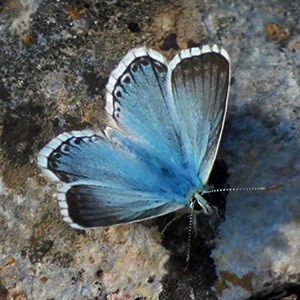 A very bright example of a Cantabrican male Chalkhill
A very bright example of a Cantabrican male Chalkhill
Blue. Upperside colouration varies so much between
individuals that it regularly invites confusion, though
Spanish Chalkhill Blue hasn't been recorded from
Asturias yet
Polyommatus coridon asturiensis© John Muddemanrecord, but still in much less dry conditions than 2013, it was still a bit of a surprise coming from roasting C Spain to meet at Bilbao airport in relatively cool, but still mild and muggy conditions. However, coinciding with a front arriving, as we went through the day this varied to include lovely sun, oppressive murky mist, heavy downpours and then breezy broken cloud and sun to round off!! A significant breeze set the standard for the rest of the tour, in marked contrast to the previous two years. It certainly didn’t put us off exploring all the respective areas, though naturally it did slightly hamper our visits to the highest altitude sites in both areas. A fresh crop of late flowers and freshly emerging butterflies were excellent recompense following the rain though.
However, another major difference this time was the inclusion of a couple of visits to coastal wetlands at the beginning and end of the trip (though Pat’s earlier return flight meant she missed the latter), which added considerable variety to the birdlife seen and extra interest to the trip overall. Indeed we started the tour with a very rewarding short walk at the top of an estuary where highlights included a fine fly-over adult Purple Heron, a tired migrant Bar-tailed Godwit, plenty of Common Sandpipers and Whimbrel, a few Common Greenshanks and Common Redshanks, plus single Western Cattle Egret, Common Ringed Plover and a juvenile Curlew Sandpiper. A couple of Iberian Wall Lizards and Red-veined Darters kicked off the non-bird lists, while a late lunch at a ‘normal’ roadside bar was a delight with delicious -and cheap- Spanish fare. We also spent 45 minutes on the last day at an estuary, which thanks to a low but rising tide produced a wealth of new species on the beach in front. New trip 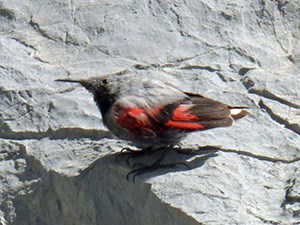 A moulting Wallcreeper; one of two we saw together
A moulting Wallcreeper; one of two we saw together
in the Picos that bizarrely spent most of their time
feeding on or close to the ground under fine limestone
rubble and rocks.
Tichodroma muraria© John Muddemanbirds included a couple of Great Crested Grebes, single European Shag, Eurasian Oystercatcher, and juvenile Red Knot and Sanderling, two Mediterranean and a surprise subadult Great Black-backed Gull and single perched Sandwich and a fly-by ‘Commic’ Tern, which didn’t come close enough to quite clinch it was the Arctic it looked most like!
The birds for the remainder of the tour were very much as expected, and being late summer in the mountains it is often surprisingly difficult to ‘dig’ out moulting adults or dispersing young birds. The prevailing windy conditions on the high tops and mountain passes meant that higher altitude species were actually poorer than hoped at the start. But, the final tally included no less than three glorious Wallcreepers, two of these feeding, bizarrely, mostly on the ground under rubbly scree, though one came out to sing for us, and another in Somiedo showed well on and off for around 45 minutes as it crept, jumped, fluttered and picked its way along the base of a limestone bluff, largely in the lee of a powerful gusting wind. The same fierce wind also brought down a couple of feeding Alpine Choughs and a lovely spotty Common Rock Thrush perched quietly in the lee of a huge boulder and unseen by the great majority of passers-by.
Raptors again featured highly, from the abundant Common Buzzards, Eurasian Kestrels 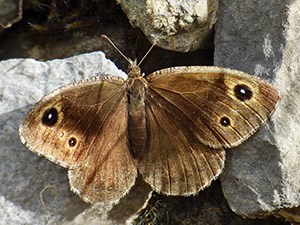 Upperside of a female Black Satyr. Superficially very
Upperside of a female Black Satyr. Superficially very
similar in flight to the Tree Graylings which were
on the same slope, the underside is very different
of course. This was one of two females at a new site
in the park in a valley notably further N and lower
than previous records.
Satyrus actaea© John Muddemanand Griffon Vultures, through plenty of Short-toed Eagles that were still scouring the hillsides for reptiles and one or two Eurasian Sparrowhawks were seen passing almost daily. Scarcer species included a few Egyptian Vultures in the Picos and four easy-to-overlook European Honey-buzzards in Somiedo, a couple of Peregrines, plus single young Golden Eagle and a lovely orange-breasted juvenile Northern Goshawk, which was a first for several of the group. The latter cruised over our final evening bear watch, before landing in a high beech tree, but then came out from its cryptic perch to sun itself on the side of a cliff in the subalpine zone making every moment of the wait worthwhile!
A large flock of wheeling and ‘chittering’ Alpine Swifts livened up an evening stroll in the Picos, while a few single Common Swifts were still wandering through during the week, presumably on migration. A few Great Spotted Woodpeckers were seen, unlike their Iberian Green cousins, which were only heard, but couple of Red-backed Shrike families, including young with still short tails gave us some superb views near one of our car parks, especially to Gill when she returned early on a couple of occasions for a rest! Red-billed Choughs were noted widely in small number, Eurasian Jays were very evident in the forests, Common Ravens ‘cronked’ in the valleys, Eurasian Crag Martins were common amongst the gathering mixed hirundine flocks, but other passerine migrants were very scarce. A couple of male Common Redstarts were colourful additions  A male Baton Blue with characteristic semi-chequered
A male Baton Blue with characteristic semi-chequered
wing fringes and dark discal marks. A very local
species in Asturias, two males were again present at
a site we discovered last year which is probably new
for the region.
Scolitantides baton© John Muddeman to the Picos list, while Northern Wheatears, numerous Mistle Thrushes and Black Redstarts, a Common Whitethroat, two Firecrests, Tree and a couple of last-minute Water Pipits, and calling Iberian Chiffchaffs in Somiedo were also undoubtedly all local breeding birds, but a single Willow Warbler, a few Spotted and Pied Flycatchers and a calling Common Nightingale was almost certainly migrants. Indeed, Northern Spain is an interesting mix, combining classically ‘Mediterranean’ with more northern species and above species combined with others such as Marsh Tit, the very localised Spotless Starling, White-throated Dipper, Grey Wagtail, Yellowhammer, Rock and Cirl Buntings and Eurasian Bullfinch is a fun one!
The butterflies were once again excellent, despite requiring more work to find them in the generally cooler and often cloudier conditions, but a judicious choice of sites to visit them in appropriate weather pulled off, with 61 species being seen in total. In fact no less than 7 of these were new, including two Wood Whites, Small pearl-bordered and Spotted Fritillaries, a few Short-tailed Blues, plenty of Meadow Fritillaries and a single long-awaited, but brief, Cardinal. Other southern gems included Red-underwing, Oberthür’s Grizzled and Southern Grizzled Skippers, Spanish Swallowtail, Scarce and Sooty Coopers, a host of blues including Lang’s Short-tailed, Baton and Turquoise Blues, and Spanish, Mountain and Spanish Brown Arguses, whatever the latters’ taxonomic statuses might be! Berger’s Clouded Yellow and Cleopatra added a splash of colour, while numerous fritillaries included late High Brown, Queen-of-Spain, and several Weaver’s. Single Large Wall brown, Dusky Heath, Chapman’s Ringlet (phew! It nearly escaped us!) and 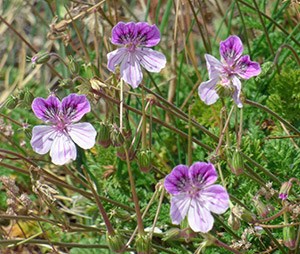 Foodplant of the very local & endemic Spanish Argus
Foodplant of the very local & endemic Spanish Argus
butterfly here, the beautiful Rock Storksbill was
in full flower again after summer rains, enabling
us to find another small extension to the site for
both species found in 2013.
Erodium foetidum glandulosum© John MuddemanGreat Banded Grayling were excellent, while plenty of Rock Graylings were still on the wing this year, as were Tree Grayling, the males being confusable with the few Black Satyrs we saw at a couple sites, including a small colony in a new valley further N than we’ve recorded this rare Asturian butterfly before.
Heavy rain just before the tour in some areas had also rewarded us with plenty of Autumn Crocus in some fields, while other drifts of pink were of the similar-looking (but stemless) Merendera, which was also a favoured nectaring plant for long-tongued butterflies! The remaining flora included a few showy Fringed Pinks, while otherwise we mostly noted part of the incredible and exciting diversity of species present when it influenced our searches for butterflies! Some beautiful clumps of Rock Storksbill Erodium foetidum in full flower on a roadside led me to discover a new site for Spanish Argus, while the blue-flowered spikes of Hyssop nearby were once again a main nectar source for a range of lycaenids (i.e. blues & coppers!) and a stand of a ragwort over in León was once again a target for hungry butterflies, including numerous Scarce Coppers and our lone male Chapman’s Ringlet.
The same rain and cooler conditions had clearly reduced the overall number of butterflies and insects compared to previous years, but plenty of other wildlife was also seen, including a few Praying Mantises, 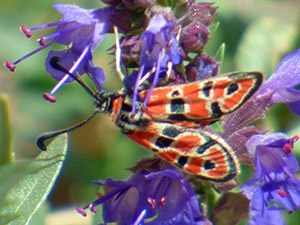 A poor shot of the exquisite Red-collared Burnet
A poor shot of the exquisite Red-collared Burnet
feeding on the flowers of Hyssop, a magnet to
nectaring butterflies and day-flying moths
Zygaena fausta© John MuddemanGreat Green Bush-Cricket and Wartbiter, two amazingly fast Western Three-toed Skinks, a very few León Rock, common Common Wall, numerous Iberian Wall and a single brief juvenile Schreiber’s Green Lizards. A sloughed snake skin up a mountain was probably a Montpellier cast-off, while a flat Fire Salamander on a track nearby was sad testament to their presence here, but it had undoubtedly been enticed out by the same rain. A couple of Spanish Pool Frogs in a water channel looked healthy enough though. The 6-spot burnet moths at a few sites were the local Zygaena subalpina, while the incredible bright individual was the lovely Red-collared Burnet, and other notable species included the colourful Jersey Tiger and plenty of Hummingbird Hawk-moths. Dragonflies provided entertainment, especially as Jeff was keen to look at one or two, and not only did we see Western Spectre at two sites, but one bizarrely flew past me, jinked sharply down to collide with a shiny signpost, and dropped temporarily stunned at my feet, just as we arrived to Somiedo! Great for occupying the photographers while I went to organise the rooms! Other individuals were behaving more normally of course, as were a few impressive Common Goldenrings, a male Keeled Skimmer, a few scattered Migrant Hawkers, and single male and female Southern Hawkers in quick succession on our day over into N León.
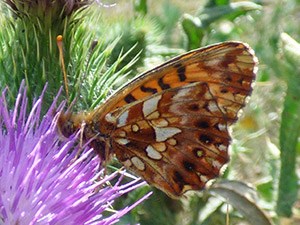 The pretty Weaver's Fritillary was quite frequent this
The pretty Weaver's Fritillary was quite frequent this
year. Note the sharply angled hindwing very character-
istic among the late summer fritillary species here.
Clossiana dia© John MuddemanSo, WHAT ABOUT THE BEARS? I hear you ask… Well, it couldn’t have been more striking in comparison to previous years! To put it into perspective, a severe frost fell in May this year, destroying the Bilberry flowers and resulting in near zero fruiting. Added to this, the generally very warm and rather dry conditions prevailing through spring and summer meant that in contrast, the Alpine Buckthorn, one of the bear’s favourite food supplies had not only started ripening in late July, but had finished suddenly with the remaining fruit falling due to the heavy rains! With blackberries and hazelnuts also largely failing throughout the region, the bears were (and are) having a tougher time than usual this year to find food until the abundant acorn crop ripens. In addition, this of course includes not being drawn out into the open to feed on these resources… Our first morning in Somiedo saw nearly all of us up for a dawn watch and somewhat braving out the stiff and gusting wind at a temperature of 9ºC. A few bears were being seen in the area, but we were well rewarded when we found our own very large and black male bear as it walked up out of the forest opposite and then weaved its way through the scrub and boulders before finally disappearing over the hilltop. Brilliant!
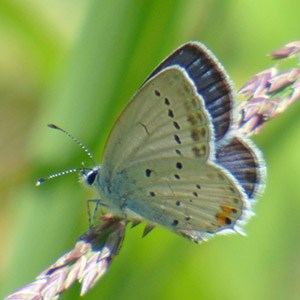 One of several Short-tailed Blues, which was a
One of several Short-tailed Blues, which was a
new species for the tour, but seen at a couple of sites
Cupido argiades© John MuddemanReturning a little later than expected for breakfast saw us passing another group of watchers who were peering intensely at another bear (as I discovered later), but with the ‘job done’ we were more than happy to try again over the following days. Which we did five more times, at three different sites, though to no avail! The bears suddenly became erratic and seen in very small number from that moment on, though the gale force winds at the main viewpoint on the two subsequent days meant it was all but impossible to watch there properly and the warming conditions again put the bears back under forest cover over the remaining days. Small groups of Southern Chamois, a couple of lovely Red Foxes hunting in meadows and three stag red deer and two females the following morning were decent rewards for the remaining watches. We were actually also incredibly lucky with the weather, which has been forecast as basically cloudy, cold and wet there since we left!
While our collaboration with the Brown Bear Foundation (FOP in Spanish) had changed this year, with a rival company gaining exclusive access to their wardens for guiding purposes, we were still delighted to visit the Casa del Oso in Pola de Somiedo during our visit and sign all the party members up as members of FOP for a year. Once again Fernando Ballesteros came over to give us a talk on the status and conservation of Brown Bears in the Cantabrican Mountains (and the Pyrenees during the questions session), and I would like to thank the FOP not only for this, but also for providing us with general information on recent sightings through FOP president Guillermo Palomero, plus wardens Toño and Marcos in Pola and also  A fresh Silver-spotted Skipper feeds on a lovely
A fresh Silver-spotted Skipper feeds on a lovely
Merendera flower
Hesperia comma© John MuddemanLuis, in León, who we bumped into while enjoying a day ‘over the border’!
I would like to say a big thank you to all the participants for making this such an enjoyable tour. The good humour throughout meant it was ‘easy’ to lead, and judging from the feedback was very enjoyable, as we hoped! Even Gill, who missed the only bear, has been twice before and so was not unduly affected! It is also timely to thank our accommodation in both the Picos de Europa and Somiedo for attending to our requests and needs willingly and with unfailing good humour at sometimes slightly complicated hours.
Please note that the 2016 tour will return to combining Villablino with Somiedo (as in 2014) and will be run during the last full week of August. This should coincide either with the spread of dates possible running from either the end of a very early fruiting year, or the start of a late fruiting one!
[Please note that the quality of the pictures this year is poor. In order to make sure everyone got good views of the bear, the scope was dedicated to group use instead of digiscoping of course, and my bridge camera is starting to play-up anyway...!]
.
.
.
BIRDS - AVES
Mallard Anas platyrhynchos  A worn example of the endemic Spanish Argus
A worn example of the endemic Spanish Argus
Aricia morronensis morronensis© John Muddeman
Great Crested Grebe* Podiceps cristatus
Western Cattle Egret* Bubulcus ibis
Grey Heron Ardea cinerea
Purple Heron* Ardea purpurea
Little Egret* Egretta garzetta
European Shag* Phalacrocorax aristotelis
Great Cormorant Phalacrocorax carbo
European Honey-buzzard Pernis apivorus
Egyptian Vulture Neophron percnopterus
Griffon Vulture Gyps fulvus
Short-toed Snake-eagle Circaetus gallicus
Eurasian Sparrowhawk Accipiter nisus
Northern Goshawk Accipiter gentilis
Common Buzzard Buteo buteo
Golden Eagle Aquila chrysaetos
Common/Eurasian Kestrel Falco tinnunculus
Peregrine Falcon Falco peregrinus
Eurasian Coot* Fulica atra
Eurasian Oystercatcher* Haematopus ostralegus
Common Ringed Plover* Charadrius hiaticula
Bar-tailed Godwit* Limosa lapponica
Whimbrel* Numenius phaeopus
Eurasian Curlew* Numenius arquata
Common Redshank* Tringa totanus
Common Greenshank* Tringa nebularia
Common Sandpiper* Actitis hypoleucos 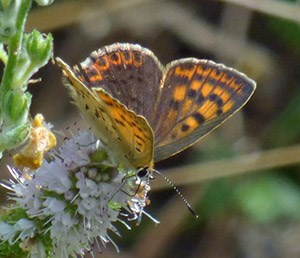 A smart female Sooty Copper
A smart female Sooty Copper
Lycaena tityrus© John Muddeman
Red Knot* Calidris canutus
Sanderling* Calidris alba
Curlew Sandpiper* Calidris ferruginea
Dunlin* Calidris alpina
Black-headed Gull Chroicocephalus ridibundus
Mediterranean Gull* Ichthyaetus melanocephalus
Great Black-backed Gull* Larus marinus
Yellow-legged Gull Larus michahellis
Lesser Black-backed Gull* Larus fuscus
Sandwich Tern* Thalasseus sandvicensis
Arctic/Common Tern* Sterna paradise / hirundo
Rock Dove / Feral Pigeon Columba livia
[Common] Wood Pigeon Columba palumbus
Eurasian Collared Dove Streptopelia decaocto
Tawny Owl Strix aluco H
Alpine Swift* Tachymarptis melba
Common Swift Apus apus
Common Kingfisher Alcedo atthis
Great Spotted Woodpecker Dendrocopos major
Iberian Green Woodpecker Picus (viridis) sharpei H
Red-backed Shrike Lanius collurio
Eurasian Jay Garrulus glandarius
Eurasian Magpie Pica pica 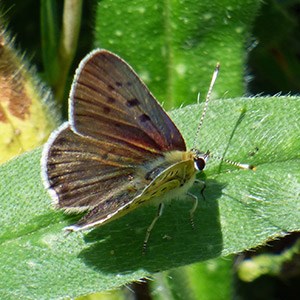 And a male Sooty Copper with dark upperwing
And a male Sooty Copper with dark upperwing
Lycaena tityrus© John Muddeman
Red-billed Chough Pyrrhocorax pyrrhocorax
Alpine Chough Pyrrhocorax graculus
Carrion Crow Corvus corone
Northern/Common Raven Corvus corax
Coal Tit Periparus ater H
Great Tit Parus major
Blue Tit Cyanistes caeruleus
Barn Swallow Hirundo rustica
Eurasian Crag Martin Ptyonoprogne rupestris
[Common] House Martin Delichon urbicum
Long-tailed Tit Aegithalos caudatus H
Willow Warbler Phylloscopus trochilus
Iberian Chiffchaff Phylloscopus ibericus H
Blackcap Sylvia atricapilla
Common Whitethroat Sylvia communis
Firecrest Regulus ignicapilla
Eurasian Wren Troglodytes troglodytes
Eurasian Nuthatch Sitta europea
Wallcreeper* Tichodroma muralis
Short-toed Treecreeper* Certhia brachydactyla H
Spotless Starling Sturnus unicolor
Common Blackbird Turdus merula
Song Thrush Turdus philomelos
Mistle Thrush Turdus viscivorus
European Robin Erithacus rubecula
Common Nightingale* Luscinia megarhynchos H
Black Redstart Phoenicurus ochruros 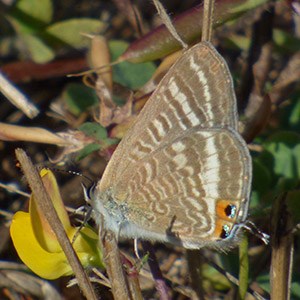 Long-tailed Blue: notably common in Spain this year
Long-tailed Blue: notably common in Spain this year
and a number were seen at different sites on the tour
Lampides boeticus© John Muddeman
Common Redstart Phoenicurus phoenicurus
European Stonechat Saxicola rubicola
Northern Wheatear Oenanthe oenanthe
Common Rock Thrush Monticola saxatilis
Spotted Flycatcher Muscicapa striata
Pied Flycatcher Ficedula hypoleuca
White-throated Dipper Cinclus cinclus
House Sparrow Passer domesticus
Dunnock / Hedge Accentor Prunella modularis
Western Yellow Wagtail Motacilla flava
Grey Wagtail Motacilla cinerea
White Wagtail Motacilla alba
Tree Pipit Anthus trivialis
Water Pipit Anthus spinoletta
Common Chaffinch Fringilla coelebs
European Serin Serinus serinus
European Greenfinch Carduelis chloris
European Goldfinch Carduelis carduelis
Common Linnet Carduelis cannabina
Eurasian Bullfinch Pyrrhula pyrrhula
Yellowhammer Emberiza citrinella
Rock Bunting Emberiza cia
Cirl Bunting Emberiza cirlus
MAMMALS - MAMMALIA
European Rabbit Oryctolagus cuniculus
Red Fox Vulpes vulpes
Brown Bear Ursus arctos  Sometimes surprisingly similar to Long-tailed,
Sometimes surprisingly similar to Long-tailed,
Lang's Short-tailed Blue is darker and generally
much commoner too!
Leptotes pirithous© John Muddeman
Red Deer Cervus elaphus
Isard / Southern Chamois Rupicapra pyrenaica
REPTILES - REPTILIA
León Rock Lizard Iberolacerta monticola
Common Wall Lizard Podarcis muralis
Iberian Wall Lizard Podarcis hispanica
AMPHIBIANS - AMPHIBIA
Fire Salamander Salamandra salamandra dor
Spanish Pool Frog* Pelophylax perezi
BUTTERFLIES - LEPIDOPTERA
Mallow Skipper Carcharodus alceae
Southern Grizzled Skipper* Pyrgus (malvae) malvoides
Oberthür's Grizzled Skipper Pyrgus armoricanus
Grizzled Skipper Pyrgus sp.
Red Underwing Skipper Spialia sertorius
Lulworth Skipper Thymelicus acteon
Silver-spotted Skipper Hesperia comma
Large Skipper Ochlodes sylvanus
Swallowtail Papilio machaon
Spanish (Scarce) Swallowtail Iphiclides (podalirius) feisthamelii
Wood White* Leptidea sinapis / reali 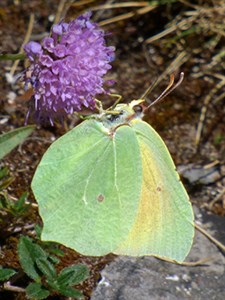 A lovely crisp male Cleopatra
A lovely crisp male Cleopatra
Gonepteryx cleopatra© John Muddeman
Small White Pieris (Artogeia) rapae
Green-veined White Pieris (Artogeia) napi
Large White Pieris (Artogeia) brassicae
Bath White* Pontia daplidice
Clouded Yellow Colias crocea
Berger's Clouded Yellow Colias alfacariensis
Cleopatra Gonepteryx cleopatra
Brimstone Gonepteryx rhamni
Purple Hairstreak Favonius quercus
Small Copper Lycaena phlaeas
Scarce Copper Lycaena virgaureae
Sooty Copper Lycaena tityrus
Long-tailed Blue Lampides boeticus
Lang's Short-tailed Blue Leptotes pirithous
Short-tailed Blue* Cupido (Everes) argiades
Holly Blue Celastrina argiolus
Baton Blue Scolitantides (Pseudophilotes) baton
Mountain Argus Plebejus (Aricia) (artaxerxes) montensis
Spanish Brown Argus Plebejus (Aricia) (agestis) cramera
Spanish Argus Plebejus (Aricia) morronensis
Turquoise Blue Polyommatus (Plebicula) dorylas
Common Blue Polyommatus icarus
Adonis Blue Polyommatus bellargus
Chalkhill Blue Polyommatus (Lysandra) coridon
Speckled Wood Pararge aegeria
Large Wall Brown Lasiommata maera
Wall Brown Lasiommata megera
Dusky Heath Coenonympha dorus 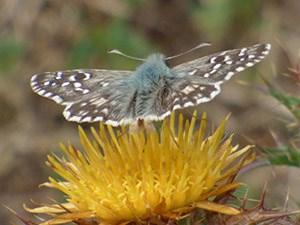 'Dusted' upperside of a presumed Southern Grizzled
'Dusted' upperside of a presumed Southern Grizzled
Skipper
Pyrgus malvoides© John Muddeman
Small Heath Coenonympha pamphilus
Gatekeeper Pyronia tithonus
Meadow Brown Maniola jurtina
Chapman's Ringlet Erebia palarica
Great Banded Grayling Brintesia circe
Grayling Hipparchia (Parahipparchia) semele
Rock Grayling Hipparchia hermione (=alcyone)
Tree Grayling Hipparchia (Neohipparchia) statilinus
Black Satyr Satyrus actaea
Marbled White Melanargia galathea
Red Admiral Vanessa atalanta
Comma Polygonia c-album
Small Tortoiseshell Aglais urticae
High Brown Fritillary Argynnis (Fabriciana) adippe
Silver-washed Fritillary Argynnis paphia
Cardinal Fritillary* Argynnis (Pandoriana) pandora
Queen of Spain Fritillary Issoria lathonia
Small Pearl-bordered Fritillary* Clossiana selene
Weaver's/Violet Fritillary Clossiana (=Boloria) dia
Knapweed Fritillary Melitaea phoebe
Spotted Fritillary* Melitaea didyma
Meadow Fritillary* Melitaea (Mellicta) parthenoides
MOTHS - LEPIDOPTERA 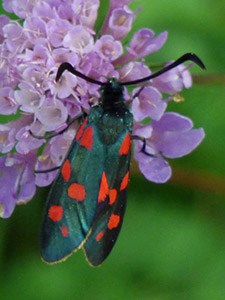 The local 6-spotted Southerly Burnet
The local 6-spotted Southerly Burnet
Zygaena transalpina© John Muddeman
Southerly Burnet moth Zygaena transalpina
Red-necked Burnet Zygaena fausta
Hummingbird Hawkmoth Macroglossum stellatarum
Speckled Footman Cybosia cribraria
Jersey Tiger Euplagia quadripunctaria
DAMSELFLIES & DRAGONFLIES - ODONATA
Migrant Hawker Aeshna mixta
Blue Hawker Aeshna cyanea
Western Spectre Boyeria irene
Common Goldenring Cordulegaster boltonii
Keeled Skimmer Orthetrum coerulescens
Red-veined Darter Sympetrum fonscolombii
OTHER SELECTED INSECTS - INSECTA
Red-winged Grasshopper ??
Blue-winged Grasshopper ??
Great Green Bush-cricket Tettigonia viridissima
Wart-biter Decticus verrucivorus
Praying Mantis Mantis religiosa
Italian Striped/Minstrel Bug Graphosoma lineatum
LARGER FISH - PISCES
Brown Trout Salmo trutta
Read more blog posts